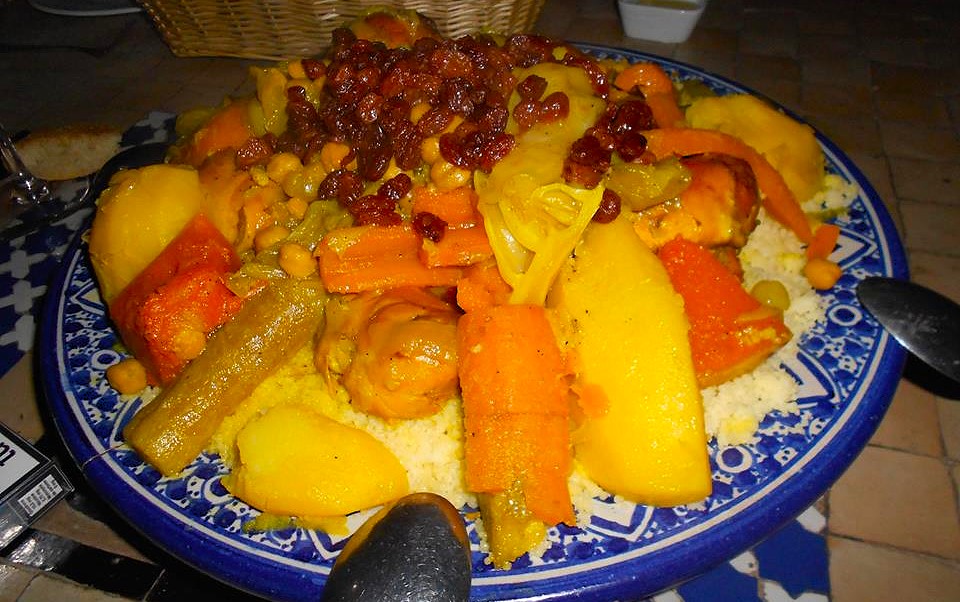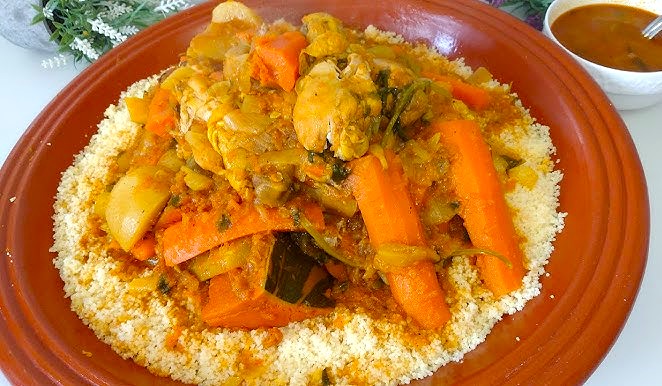Moroccan Couscous: The Heart of Morocco’s Culinary Heritage
Few dishes embody Morocco’s culinary soul like Moroccan couscous. Revered across generations, this steamed semolina grain is more than just a staple, it is a symbol of family, tradition, and celebration. Whether served at a daily meal or a festive gathering, Moroccan couscous brings people together, representing the shared warmth and hospitality that define Moroccan culture.
Couscous is often paired with slow-cooked meats, vegetables, and rich sauces, each variation reflecting the regional flavors and ingredients of Morocco. From the aromatic lamb and vegetable couscous of Fes to chicken and seven-vegetable couscous in Marrakech, every dish tells a story of history, geography, and cultural exchange.
This dish is also a work of culinary artistry. Preparing couscous requires patience, skill, and care — whether steaming the semolina to perfect fluffiness, layering vegetables and meats, or infusing the dish with saffron, cumin, and cinnamon. Every bite is a celebration of flavor, texture, and tradition.
Exploring Moroccan couscous provides travelers with an authentic taste of Morocco, connecting them to centuries of family traditions, regional ingredients, and festive rituals. For those seeking to understand Morocco through its cuisine, couscous is the perfect starting point.

History and Cultural Significance of Moroccan Couscous
Moroccan couscous has a long and fascinating history that reflects the country’s diverse cultural influences. Thought to have originated with the Amazigh (Berber) people, couscous was traditionally made from steamed semolina grains and served with vegetables or meat. This method of cooking allowed families to prepare hearty, nourishing meals that could feed large groups, making couscous a symbol of community and togetherness.
Over centuries, couscous evolved through the influence of Arab traders, Andalusian immigrants, and Mediterranean culinary traditions, who introduced new spices, vegetables, and cooking techniques. The dish became a central part of Moroccan culture, served during religious holidays, weddings, and family gatherings, representing both nourishment and celebration.
Today, couscous is not only a daily staple but also a culinary emblem of Morocco, enjoyed in both humble homes and upscale restaurants. Travelers exploring Morocco can taste this iconic dish in cities like Marrakech and Fes, where local chefs preserve traditional recipes while introducing regional variations.
Learning about the history of Moroccan couscous provides a deeper appreciation for its cultural significance. It is not just food; it is a connection to Morocco’s heritage, family traditions, and regional diversity.
Ingredients and Flavors: What Makes Moroccan Couscous Special
The magic of Moroccan couscous lies in its simple yet versatile ingredients, which transform into a dish full of texture, aroma, and flavor. Each component contributes to the harmony that has made couscous a staple of Moroccan cuisine for centuries.
The Base: Steamed Semolina Grains
At the heart of every couscous dish is semolina, a type of durum wheat. Steamed carefully, the grains become light, fluffy, and slightly nutty, providing the perfect canvas for vegetables, meats, and spices. Mastering the steaming process is key, whether done traditionally over a couscoussier or in modern kitchens.
Vegetables and Legumes
Moroccan couscous often features a variety of seasonal vegetables such as carrots, zucchini, pumpkin, turnips, and chickpeas. These ingredients not only add color and texture but also reflect the regional diversity and freshness of Moroccan produce. Vegetables are typically slow-cooked with spices to infuse the dish with rich, aromatic flavors.
Meat and Protein Options
Couscous is commonly paired with lamb, chicken, or beef, slow-cooked until tender in a spiced sauce. In coastal regions, fish or seafood couscous is popular, often prepared with tomatoes, peppers, and local herbs. For vegetarian or vegan variations, legumes and seasonal vegetables provide hearty, flavorful alternatives.
The Spice Symphony
The defining characteristic of Moroccan couscous is its aromatic spice blend. Key spices include cumin, coriander, cinnamon, ginger, and turmeric, often combined with saffron for a luxurious aroma. These spices are sometimes enhanced by ras el hanout, the famous Moroccan spice mix that can include up to 30 different ingredients, giving the dish its complex and memorable flavor.
Optional Additions
Many regional recipes include dried fruits like raisins or apricots, toasted almonds, or fresh herbs such as parsley and coriander, adding sweet, nutty, or fresh notes. These touches highlight the Moroccan talent for balancing flavors, creating a dish that is rich, layered, and satisfying.
Exploring the ingredients and flavors of Moroccan couscous allows travelers to understand why it is both a daily staple and a ceremonial dish, connecting generations and regions through a shared culinary tradition.
Regional Variations of Moroccan Couscous
While Moroccan couscous is a beloved national dish, each region adds its own unique twist, reflecting local ingredients, climate, and cultural influences. Exploring these variations provides travelers with a full taste of Morocco’s culinary diversity.
Fes: Refined and Aromatic Couscous
In Fes, couscous is prepared with lamb, seven vegetables, and carefully balanced spices. Fes is known for its refined culinary traditions, where each ingredient is thoughtfully combined to create a dish that is both elegant and flavorful. Couscous in Fes often includes saffron and ras el hanout, giving it a distinctive aroma that reflects the city’s royal heritage.

Marrakech: Sweet and Spicy Couscous
In Marrakech, couscous is often enriched with dried fruits such as apricots and raisins, providing a natural sweetness that complements spiced lamb or chicken. The city’s vibrant souks and spice markets inspire these bold, aromatic flavors, making Marrakech couscous an adventure for the senses.

Rif Mountains and Chefchaouen: Rustic and Earthy
In the Rif Mountains and the blue city of Chefchaouen, couscous is simpler and more rustic. Local chefs emphasize fresh vegetables, legumes, and locally raised meats, resulting in a dish that is hearty, wholesome, and deeply connected to the land. These recipes highlight the authenticity and sustainability of Moroccan rural cuisine.

Sahara and Southern Morocco: Hearty Desert Couscous
In the Sahara and southern regions, couscous becomes a hearty, nourishing meal. Often served with camel or lamb, chickpeas, and root vegetables, this variation provides sustenance for long journeys across the desert. Spices are used generously, reflecting the region’s preference for bold, warming flavors.

Cooking Techniques: How Moroccan Couscous Is Prepared
Creating authentic Moroccan couscous is both a science and an art. From preparing the semolina to steaming the grains perfectly, each step requires care and attention to detail. Travelers who witness or participate in couscous preparation gain a deeper appreciation for this cultural and culinary treasure.
The Couscoussier: Traditional Steaming Tool
The foundation of couscous preparation is the couscoussier, a traditional two-tiered steamer. The lower pot holds simmering stew, while the upper tier holds the couscous grains. As steam rises, it gently cooks the semolina, keeping it light, fluffy, and aromatic. Learn more about the couscoussier and its role in Moroccan kitchens.
Fluffing and Seasoning the Grains
After the first steaming, couscous is removed and fluffed with a fork or by hand, often with a light drizzle of olive oil or butter. This process prevents clumping and ensures each grain remains separate. Additional steaming may follow, particularly in traditional recipes, to achieve the perfect texture and consistency.
Layering Flavors with Stews and Sauces
The couscous is typically served with a slow-cooked stew, known as marqa, made from meat, vegetables, legumes, and aromatic spices. The flavors from the stew infuse the couscous when served, creating a harmonious balance between the grains and the sauce. Common spices include cumin, coriander, cinnamon, turmeric, and sometimes ras el hanout, adding depth and complexity to the dish.
Optional Garnishes and Touches
Moroccan cooks often add toasted almonds, raisins, or fresh herbs to garnish the couscous before serving. These additions not only enhance the visual appeal but also add layers of flavor and texture, reflecting the Moroccan skill in combining sweet, savory, and aromatic elements.
Cooking as a Cultural Experience
Preparing couscous is more than a culinary process; it is a social and cultural activity. Families gather to steam, fluff, and serve the couscous together, emphasizing community, patience, and shared enjoyment. Travelers participating in cooking classes or food tours experience this tradition firsthand, connecting with Morocco’s hospitality and culinary heritage.
What are you waiting for?
Contact Holiday Morocco Tours to craft your unforgettable culinary journey, from hands-on couscous cooking classes and market explorations to authentic dining experiences in Morocco’s vibrant cities.
Bring the flavors of Morocco to life and savor an experience you will never forget.
Where to Taste Authentic Moroccan Couscous
To truly appreciate Moroccan couscous, travelers should experience it in its authentic setting, whether in bustling cities, rural villages, or coastal towns. Sampling couscous where it is traditionally prepared provides a cultural and culinary immersion like no other.
Fes: The City of Culinary Refinement
In Fes, couscous is a centerpiece of both daily meals and festive occasions. Family-run restaurants and traditional riads serve lamb or chicken couscous with seven vegetables, infused with saffron and regional spices. Dining in Fes allows travelers to taste recipes that have been preserved for generations, offering a direct connection to Morocco’s culinary heritage.
Marrakech: Vibrant Flavors in the Heart of the Medina
Marrakech offers a sensory feast. Street vendors, local markets, and riads provide couscous with sweet dried fruits, slow-cooked meats, and aromatic spices. Exploring the Marrakech medina while tasting couscous gives travelers a true sense of the city’s vibrant culture and history.
Rural Villages and Mountain Towns
In the Rif Mountains and rural areas, couscous is often vegetarian or paired with local meats, highlighting seasonal vegetables and herbs. Visiting a traditional Moroccan home for couscous is a unique opportunity to experience authentic hospitality, witness the steaming process, and enjoy the dish with locals.
Coastal Towns: Fresh and Light Couscous
On the Atlantic coast, particularly in Essaouira, couscous is often paired with fresh seafood, reflecting the region’s maritime influence. Local chefs combine fish, vegetables, and spices to create a dish that is light, flavorful, and uniquely coastal.
Culinary Tours and Classes
For travelers seeking a hands-on experience, joining a Moroccan culinary tour or cooking class provides an intimate look at couscous preparation. Participants can steam the semolina, layer vegetables, and cook meat, learning the techniques, flavors, and traditions that make Moroccan couscous unforgettable.
Exploring Moroccan couscous across regions allows travelers to taste history, culture, and family traditions in every bite. It is more than a dish, it is a gateway to understanding Morocco’s rich culinary heritage.
Discover Moroccan Couscous: A Culinary Journey You Can Taste
Moroccan couscous is more than just a dish, it is a symbol of tradition, hospitality, and cultural heritage. From the aromatic spices and tender meats to the colorful seasonal vegetables and dried fruits, every couscous dish tells a story of regional flavors, family traditions, and centuries of culinary artistry.
Whether enjoyed in Fes, Marrakech, the Rif Mountains, or the coastal city of Essaouira, couscous provides a direct connection to Morocco’s heart and history.
